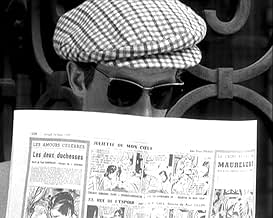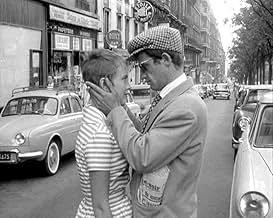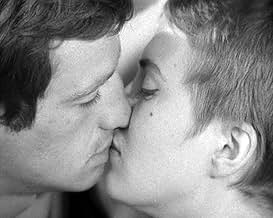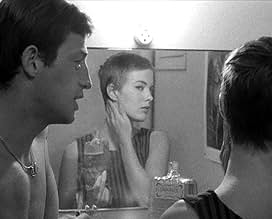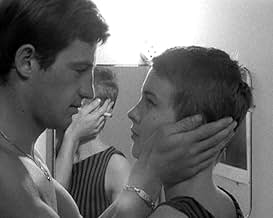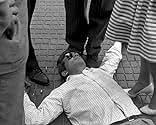Ein Schmalspurdieb stiehlt ein Auto und ermordet impulsiv einen Motorradpolizisten. Auf der Flucht vor den Behörden tut er sich mit einer hippen amerikanischen Journalismusstudentin zusammen... Alles lesenEin Schmalspurdieb stiehlt ein Auto und ermordet impulsiv einen Motorradpolizisten. Auf der Flucht vor den Behörden tut er sich mit einer hippen amerikanischen Journalismusstudentin zusammen und versucht sie zu überreden, mit ihm nach Italien zu fliehen.Ein Schmalspurdieb stiehlt ein Auto und ermordet impulsiv einen Motorradpolizisten. Auf der Flucht vor den Behörden tut er sich mit einer hippen amerikanischen Journalismusstudentin zusammen und versucht sie zu überreden, mit ihm nach Italien zu fliehen.
- Regie
- Drehbuch
- Hauptbesetzung
- Nominiert für 1 BAFTA Award
- 5 Gewinne & 4 Nominierungen insgesamt
- Michel Poiccard a.k.a. Laszlo Kovacs
- (Nicht genannt)
- Patricia Franchini
- (Nicht genannt)
- Tolmatchoff
- (Nicht genannt)
- Police Inspector Vital
- (Nicht genannt)
- Photographer
- (Nicht genannt)
- A Journalist
- (Nicht genannt)
- Man in a White Car
- (Nicht genannt)
- A Drunk
- (Nicht genannt)
- A Journalist
- (Nicht genannt)
- Liliane
- (Nicht genannt)
- …
- Police Inspector #2
- (Nicht genannt)
- The Snitch
- (Nicht genannt)
- Carl Zubart
- (Nicht genannt)
- Antonio Berrutti
- (Nicht genannt)
- A Journalist
- (Nicht genannt)
- Journalist at Orly
- (Nicht genannt)
Empfohlene Bewertungen
Although some people may not be as impressed with "Breathless" structure as they were in 1960, it remains a terrific, breathtaking film experience and has aged wonderfully. Such masterpieces live up to the hype and time, even though they're not as technically impressive as they were 40 years ago, and they're still powerful thanks to what great films consist of: passion. As another user rightfully stated, we have to look at "Breathless" from a historical point: it's different from any other previous film. Godard was truly a visionary and an incredibly talented, passionate "auteur".
"Breathless" plot is rather simple: Michel Poiccard/Laszlo Kovacs (Jean-Paul Belmondo), our anti-hero, is a young criminal on the run from the police, after stealing a car and killing a cop. He has an affair with a beautiful young American, Patricia (Jean Seberg), an aspiring journalist who sells the New York Herald Tribune in the middle of the Champs Élysées (her first scene here was paid a tribute by Eva Green in Bertolucci's "The Dreamers"), and is also expecting Michel's baby. Patricia helps Michel to dodge the police, while they steal cars together in order to raise money for a trip to Rome. But when you want to "vivre dangereusement jusqu'au bout" - or, live dangerously till the end, things may end up not so well.
When you see Belmondo touching his lips, trying to imitate Humphrey Bogart's trade mark, Seberg walking on the Élysées as lovely as a girl can be, the unforgettable final moments...you don't worry about theories on why this is a classic. "À Bout de Soufflé" is Cinema.
Roger Ebert put it best when he said that just as film fanatics may now stand outside a movie theatre waiting for the next Quentin Tarantino movie to be released, film enthusiasts were doing so for Godard in the 1960s. He was a revolutionary, which is why MovieMaker magazine called him the 4th most influential director of ALL-TIME (only behind Welles, Griffith, and Hitchcock)! What did Godard do different? Breathless is all style, simple as that. The story line is interesting, yes, but is Godard's aesthetics, production modes, subject matters, and storytelling methods that are key. First of all, the whole movie was shot on a hand-held camera, just like most all New Wave pictures. It was, however, only shot by two people (Godard and his cinematographer, Rouald) on a budget that did not top $50,000, a mere fraction of what most pictures cost at the time (another facet of the New Wave). It was shot completely on location in Paris, and utilized new film-making techniques that would be used by film-making students for decades to come (such as putting the camera in a mail cart on the Champs Elysees and following Belmondo and Seberg). Note Godard's use of American cinema influence, and how the montage art of the 1950s impacted this aesthetic.
(A brief New Wave lesson: Most New Wave directors were displeased with the "tradition of quality," or the older generation directors who, as Truffaut put it, made the "twelve or so" pictures per year that represented France at Venice and Cannes. Most of these pictures classic or modern literary adaptations, completely stagnant in artistic quality with rehashed subject matters based on historical periods. New Wave directors supported NEW tales of modern Parisian life, primarily, and were sick of the themes found in the tradition of quality films.) The storytelling methods in Breathless are perhaps the most fascinating part of the film. The jump cuts may seem lame, but one must again view them from a historical context: it had never been done before. This is exactly why Breathless is important -- practically every technique was revolutionary. They are so submerged into film-making practices now that Breathless seems typical. Yet at the time, it was, as I said prior, unprecedented.
Ironically, the pace of this movie isn't "breathless" at all. It begins abruptly and takes a while to get going: Michel (Jean-Paul Belmondo), a character we barely know, drives a stolen car around, talks at the camera, and shoots a police officer who has tried to pull him over. Then he goes to Paris and tries to borrow money from some friends, while the police-shooting plot goes undeveloped. I only became fully engaged with the introduction of Patricia (Jean Seberg), a young American who sells newspapers on the Champs-Elysees. The relationship between Michel and Patricia is the heart of the film, especially a 25-minute-long scene in Patricia's apartment where the characters smoke, flirt, and laze around in bed, though nothing really happens. That's where I really started to admire "Breathless," because I was so captivated by a scene that, on paper, doesn't sound all that captivating.
Eventually the police catch onto Michel and launch a manhunt, but this doesn't really ratchet up the suspense. Instead, Michel is (or at least, Michel acts) aimless and nonchalant about the whole thingthis is not a typical "man on the run" movie. The cool jazz score adds to the hip, laid-back tone.
Since I didn't care for the movie too much until the scenes between Michel and Patricia, I believe a lot of the credit for the film's success has to go to the charismatic performances of Belmondo and Seberg. Belmondo, with a perpetual cigarette dangling from the corner of his mouth, is the archetypal cocky criminal who models himself after Humphrey Bogart (there's a great scene where he sees some Bogart photos and gets a vulnerable look in his eyes, as though saying "I'll never be as cool as this"). Seberg plays Patricia as a confused girl who is delighted by the attention she gets as an American in France.
It's easy to see why "Breathless" was so influentialthe jump cuts, the ragged style perfectly match this story about amoral, aimless youth. Definitely a movie that expanded the range of stories the cinema can tell, and perhaps a major precursor to youth-oriented '60s culture. Nearly fifty years later, it still seems "hip," and still challenges our expectations of how movies should behave.
Well, À bout de souffle does not put you under the pressure, it takes you for a ride, and you follow for 90 minutes its incredibly young characters, common crook (Jean-Paul Belmondo) and his American free-spirited girlfriend (Jean Seberg) on their journey on the streets of 1960-th Paris along with Raoul Coutard's legendary camera. I am not going to tell here how great the camera work was, how fantastic the music score and the views of Paris were - the fans of the film know that already. They also know about the beginning of French New Wave, and how it influenced the future cinema. I just want to say that the movie was made over forty years ago - the smoking was cool back then, and Belmondo made smoking look very sexy. Belmondo fascinates me in this film. I've seen him in a lot of later movies - he's always been good (I recommend Le Magnifique, 1973 and Le Professionnel,1981 ) - but in À bout de souffle he is not just good - he is embodiment of cool, his face changes its expression every moment, you can not take your eyes off him. Is it me or he does remind the very young Mick Jagger - not commonly handsome but irresistible and sexy? He and young (she was 21 at the time) Jean Seaborg made one of the best screen couples ever. My favorite scenes:
Michel drives the stolen car in the beginning of the film, and he starts to talk to us, the audience. The day is nice, the sun is shining, and the life is beautiful...
Michel and Patricia drive in the convertible. The wind plays with her short hair. We only see the back of her head and her neck. Michel tells her that he loves the girl with a beautiful neck, wrists, knees, but she is a chicken...
Patricia comes to the hotel to find Michel in her bed. They start talking about nothing and about very serious things. They smoke, she tries to find a good place for her new poster, and he wants to sleep with her. In the end of the scene, his face, he looks at her - there is love in that look...
There is more - I am sure everyone who saw it has his/her favorite scenes.
Wusstest du schon
- WissenswertesDespite reports to the contrary, Jean-Luc Godard did not shoot the film without a script; however, he did not have a finished script at the beginning, instead writing scenes in the morning and filming them that day. See also Elf Uhr nachts (1965).
- PatzerDuring street shots, countless passersby look at Patricia and Michel and stare into the camera, revealing that the shots were made without filming barriers and simply used street pedestrians in place of extras.
- Zitate
Patricia Franchini: What is your greatest ambition in life?
Parvulesco: To become immortal... and then die.
- VerbindungenEdited into Pariz pripada nama! (2016)
Top-Auswahl
Details
- Erscheinungsdatum
- Herkunftsland
- Sprachen
- Auch bekannt als
- Sin aliento
- Drehorte
- Produktionsfirmen
- Weitere beteiligte Unternehmen bei IMDbPro anzeigen
Box Office
- Budget
- 400.000 FRF (geschätzt)
- Bruttoertrag in den USA und Kanada
- 414.173 $
- Eröffnungswochenende in den USA und in Kanada
- 32.424 $
- 30. Mai 2010
- Weltweiter Bruttoertrag
- 594.039 $
- Laufzeit1 Stunde 30 Minuten
- Sound-Mix
- Seitenverhältnis
- 1.37 : 1
Zu dieser Seite beitragen






